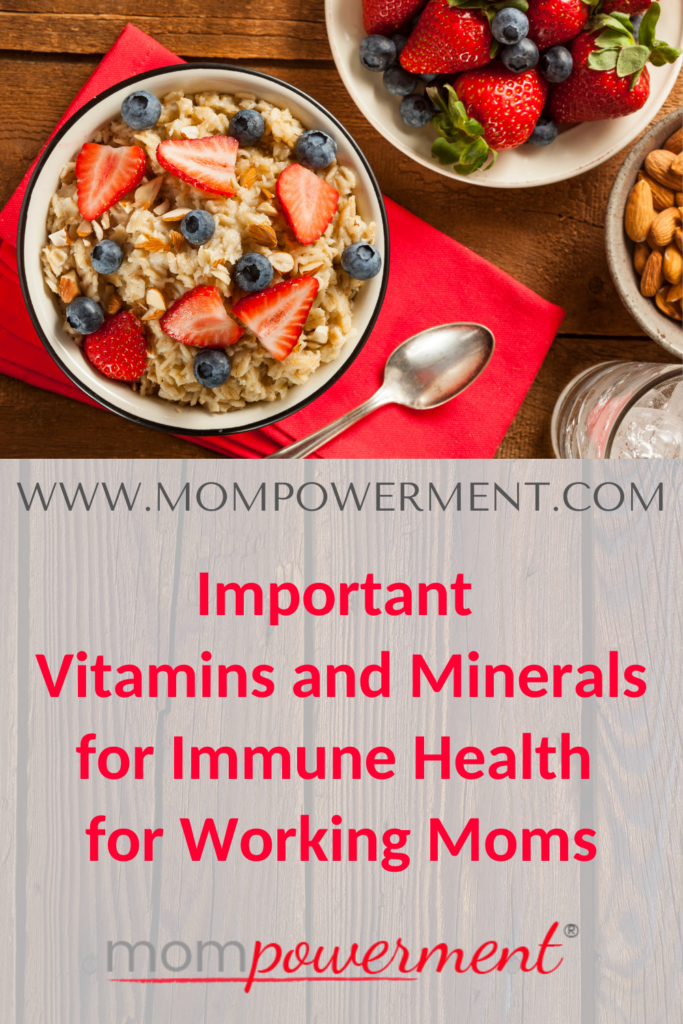
Does anyone else feel that winter and the cold just seem to outstay their welcome? My previous blogs focused on how to support your immune system during the festive season, so hopefully, you’ve started the year feeling pretty good. Unfortunately, the CDC reports that flu activity peaks in February and that’s when we’re most run down. This time around I’m focusing on immune health for working moms. I’m sharing vitamins and minerals (and their food sources) that are important and give your immune system that much-needed boost to get you through the final weeks of winter.
Your food matters
You’ve read in other Mompowerment blogs that part of the foundation of self-care is eating food that fuels you. That food can help provide immune health for working moms. The food you eat is often enough to provide sufficient levels of the nutrients you need. To be honest, food is the best source because there’s just too much goodness to put in a pill (more on that another time).
Before deciding to take any supplements, discuss all supplementation with your healthcare provider to make sure it’s the right type or mix of supplements for you. Some supplements aren’t right for everyone, and they can interfere with other medications. Don’t exceed the tolerable upper limits (UL) and try to find high-quality supplements without allergens and fillers. You might remember in my last article that I’m a fan of the Thorne Research and Garden of Life brands.
Vitamins and minerals that can help
There are many options for supplements available that can help provide immune health for working moms. I’m sharing the ones that most often help in these final weeks of winter. These are the immune-boosting vitamins and minerals that I make sure to get around this time each year and that I often see missing in my 1:1 client sessions:
Vitamin C
Vitamin C has been shown to have antiviral and antimicrobial effects and enhances the function of various types of immune cells.
Foods that are rich in vitamin C include red and green peppers, kale, parsley, collard leaves, broccoli, brussels sprouts, cauliflower, strawberries, kiwi, and many other fruits and vegetables.
Keep in mind that heat destroys vitamin C, so raw or minimally cooked foods (like steaming) are significantly better sources.
Vitamin C-rich food suggestions:
- Strawberry and spinach salad
- Baked brussels sprouts
- Kale winter salad: add carrots or roasted butternut squash, pecans, dried cranberries, some feta cheese and a red wine vinaigrette and you’re in business!
Supplementation: The US UL for vitamin C is 2000mg per day. Excess amounts of Vitamin C will likely flush from the body. Look for a supplement of about 1000mg of natural sources of vitamin C that also contains bioflavonoids to help with absorption.
Vitamin D
Vitamin D helps regulate the immune system. Research has shown that vitamin D could reduce cancer cell growth, help control infections, and reduce inflammation. A vitamin D deficiency has also been linked with various autoimmune diseases.
Sun exposure – namely the sun’s UVB rays – activates the production of Vitamin D in the body. UVB rays decrease, and with it, natural vitamin D production drops in the winter months from about the end of September to the end of March in the parts of the globe above about 35 degrees latitude (which runs through the southern borders of Tennessee and Nevada).
Egg yolks, fatty fish (like salmon), and fortified foods can supply some vitamin D.
Ways to get more Vitamin D:
- Add eggs to your salad or create a hash for any meal
- Add salmon to your salad
- Look for fortified versions of your favorite beverages and foods
- Get some sun!
Supplementation: Fortified foods help contribute to vitamin D levels. Keep in mind that Vitamin D is stored in the body, so too much vitamin D can be harmful to you. Have your doctor test your vitamin D levels and discuss supplementation with you.
Zinc
Zinc is needed for the production of new immune cells. It stimulates the immune system and has shown virus-inhibiting activity. A zinc deficiency can lead to being more susceptible to infection. Although severe zinc deficiency is rare in developed countries, marginal zinc deficiency is not uncommon. Try to get about 1-2 zinc-rich foods into your daily menu!
You can find Zinc in animal foods such as oysters, crab, lean meats, and poultry. You can also find it in pumpkin seeds, pecans, Brazil nuts, yogurt, rye, and oats.
Some ways to add more Zinc to your diet;
- Sprinkle pumpkin seeds or pecans on your salad, soup, or oatmeal
- Start your day with a yogurt parfait with a little low-sugar granola, pecans and sliced strawberries
- Grab a slice of rye bread topped with some homemade guacamole or hummus
Supplementation: The US UL for adults is 40mg/day and you should not exceed this amount. There are many vitamin C and zinc combined supplements out there.
Magnesium
Magnesium a really important mineral, necessary for countless processes in the body. It’s involved in energy production, blood sugar control, relieving constipation. It helps with vitamin D synthesis and stress management. And it helps with so much more.
Processed food often refines out a large proportion of magnesium. Foods that are high in magnesium are wheat bran, wheat germ, almonds, cashews, buckwheat, Brazil nuts, and hazelnuts.
Some ways to add more magnesium-rich foods:
- Add nuts to your salad
- Snack on nuts between meals (look for low-salt, low-sugar options)
- Sprinkle nuts on your oatmeal
- Make a healthy apple crumble (using ground nuts instead of flour)
- Serve buckwheat instead of rice as a side to your meal
Supplementation: The US tolerable UL is 350mg from supplements only. The most easily absorbed forms of magnesium are glycinate, citrate, and malate. Once you’ve gotten the go-ahead from your doctor, magnesium supplements are best taken around 30 minutes before bedtime, because they can help you relax.
Omega-3 Fatty Acids
Omega-3 fatty acids play a key role in the immune system in many ways. They help maintain the fluidity of immune cells which allows them to physically engulf invading pathogens. They help regulate the production of chemicals that kill off pathogens. Omega-3 fatty acids have also been shown to have an anti-inflammatory effect in the body.
Two of the most potent Omega-3 fatty acids – DHA and EPA – are found in fatty fish such as wild salmon, fresh tuna (not canned), mackerel, sardines, and anchovies. Other Omega-3 sources are ground flaxseeds, chia seeds and walnuts. Try to eat 2 portions of cold-water fatty fish per week, and a tablespoon of flaxseeds, chia seeds, or walnuts a day.
To get more Omega 3s in your diet:
- Bake salmon coated in a mixture of olive oil, lemon juice, Italian herb seasoning, salt and pepper
- Grab recipes for easy-to-make chia puddings
- Add chia seeds to you overnight oats and top with walnuts
- Add a handful of spiced walnuts to your oatmeal or yogurt
Supplementation: 1.1g per day of Omega-3 is recommended by the National Institutes of Health, but don’t forget to talk to your doctor first.
You’ve now got a bunch of ideas for ways to support your immune health as a working mom, especially during this time of year. What new foods will you add? What tips do you share to help fellow working moms stay healthy?

Amanda Smallwood is a nutritional therapist on a mission to support busy women take control of their health and wellness. She offers 1-to-1 consultations and group workshops (both in-person and online) and collaborates with organizations. She uses a holistic approach to her nutritional therapy practice and strives to provide helpful, actionable tips that women will be able to use based on their lifestyle. Amanda lives in London with her husband, two children, and a very fluffy cat.
Want to read some of the science behind these tips? The information was all found here:
Centers for Disease Control (CDC) (2021) Flu Season Centers for Disease Control and Prevention (Online) Found at https://www.cdc.gov/flu/about/season/flu-season.htm (last accessed 25/02/2022)
Deluca FH and Cantorna MT (2001) Vitamin D: its role and uses in immunology The FASEB Journal 15:2579-2585
Institute of Medicine (US) Panel on Micronutrients (2001) Dietary References for vitamin A, vitamin K, Arsenic, Boron, Chromium, Copper, Iodine, Iron, Manganese, Molybdenum, Nickel, Silicon, Vanadium, and Zinc National Academies Press Washington (DC) https://www.ncbi.nlm.nih.gov/books/NBK222310/?report=reader
Lupton JR Brooks JA Butte NF Caballero B Flatt JP Fried SK (2002) Dietary reference intakes for energy, carbohydrate, fiber, fat, fatty acids, cholesterol, protein, and amino acids National Academy Press: Washington, DC, USA 5 589-768
Murray M Pizzorno J Pizzorno L (2005) The Encyclopaedia of Healing Foods Piatkus London
National Institutes of Health (NIH) (2021) Omega-3 Fatty Acids Fact Sheet for ConsumersNIH Health Information (online) found at https://ods.od.nih.gov/factsheets/Omega3FattyAcids-Consumer/ accessed 24/01/2022
Qureshi AZ Zia Z Gitay MN Khan MU Khan MS (2015) Attitude of future healthcare provider towards vitamin D significance in relation to sunlight exposure Saudi Pharmaceutical Journal 23 5 523-7


